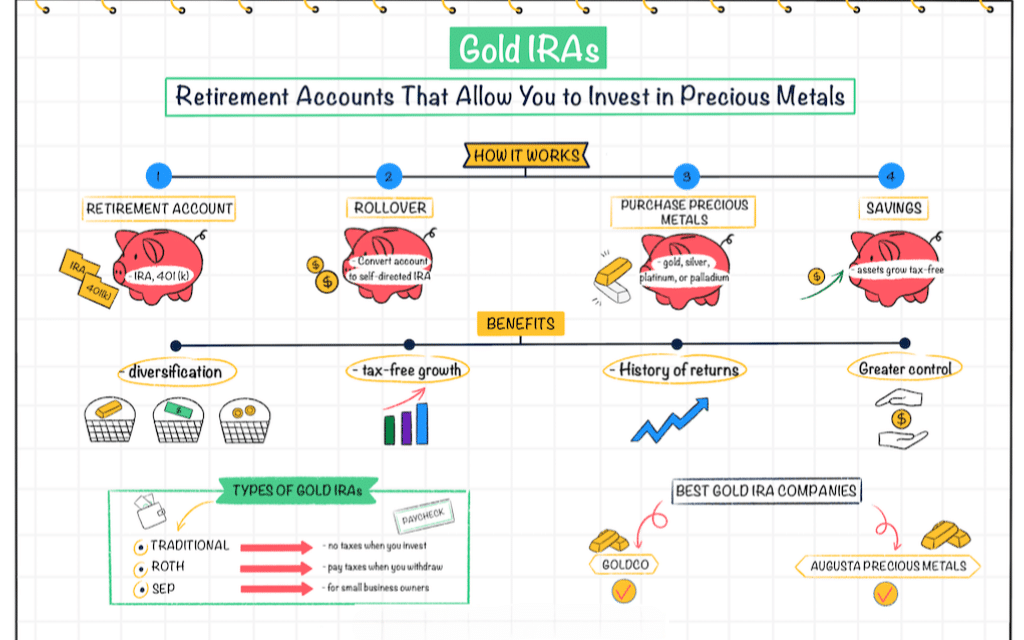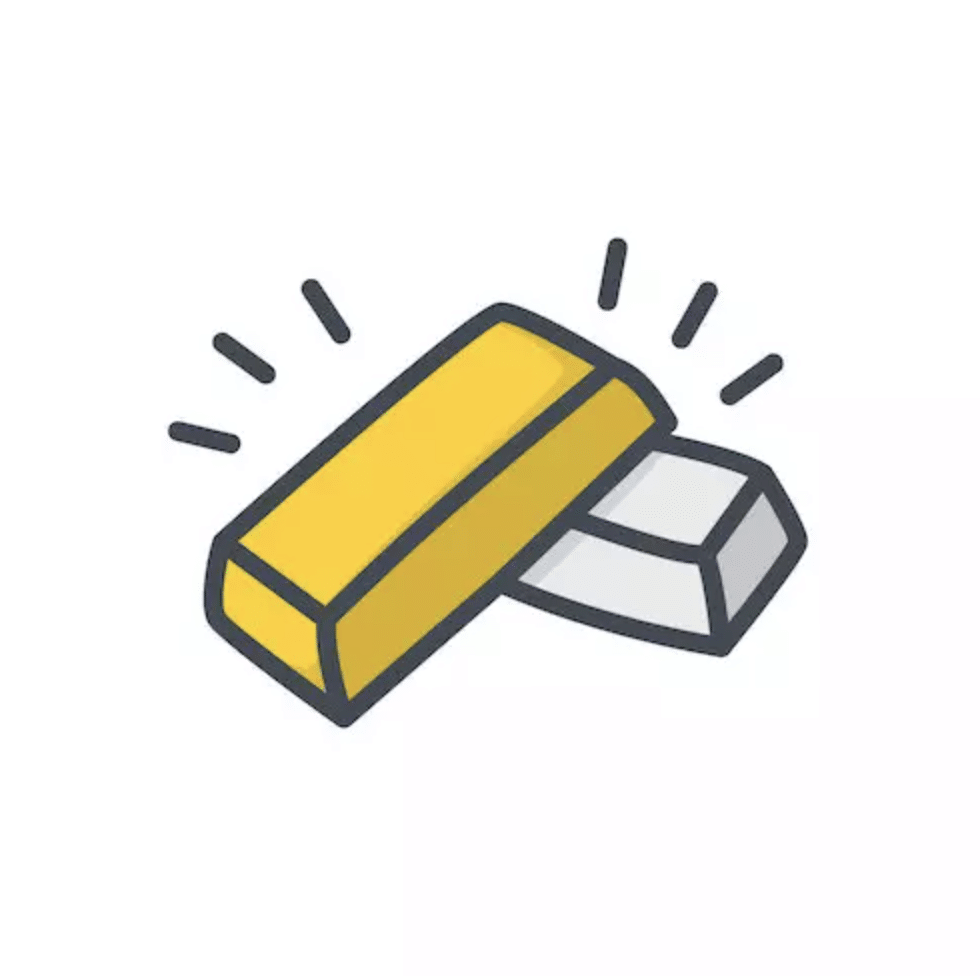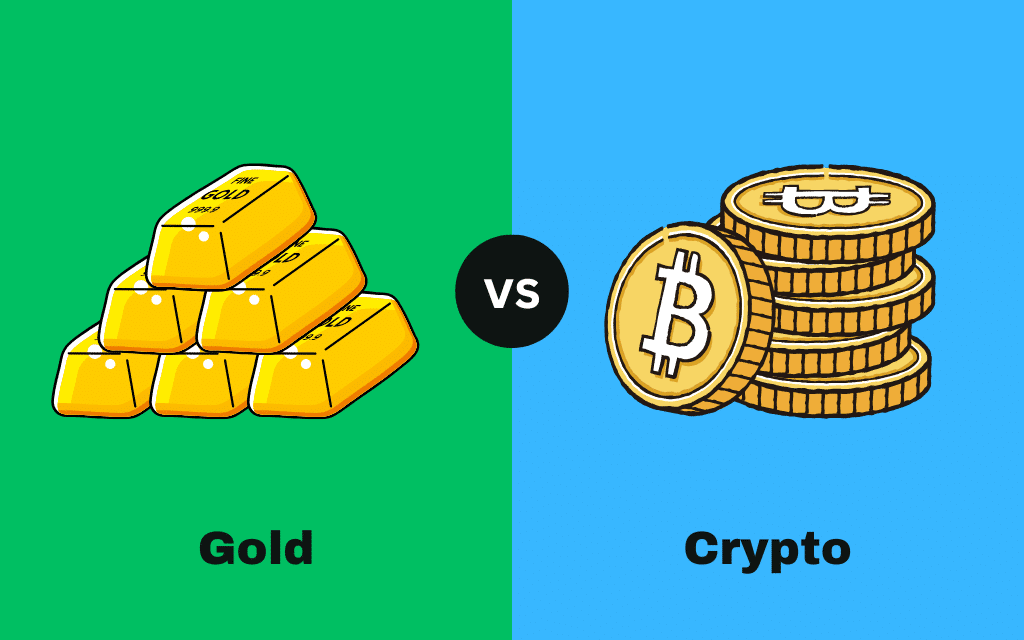Key Takeaways
- A Gold IRA is a self-directed retirement account that holds IRS-approved physical precious metals instead of traditional assets.
- Opening a Gold IRA requires a custodian, compliant metals, and secure storage in an IRS-approved depository.
- Gold IRAs offer inflation protection and diversification but involve higher fees than traditional IRAs.
- Risks include scams, lack of income generation, and stricter IRS regulations on storage and eligibility.
Confused about gold IRAs? You’re not alone. I spent weeks sifting through information and consulting experts to bring you a clear and concise guide.
This article won’t tell you it’s a magic bullet. But it will equip you with the knowledge to decide if a gold IRA fits your strategy.
What is a gold IRA?

A gold IRA is a specialized individual retirement account (IRA) designed specifically for holding physical precious metals like gold, silver, platinum, and palladium as part of your retirement savings.
Think of a gold IRA as a retirement account where, instead of stocks and bonds, you invest in physical gold (and sometimes other precious metals).
It’s like having a mini gold vault tucked away for your future. It’s a way to diversify your retirement portfolio with precious metals.
How does a gold IRA work?
Setting up a gold IRA is similar to opening a traditional IRA. You’ll work with a custodian, a specialized company that holds your gold securely.
A gold IRA allows you to hold gold and other physical metals, such as bullion and coins, within your retirement account.
Here’s the catch: the IRS doesn’t allow storing your gold IRA at home. You cannot hold physical gold at your residence; it must be stored with an approved custodian to comply with IRS regulations and ensure the safety of your assets.
Fortunately, numerous reputable IRS-approved depositories exist, like Delaware Depository, Brinks, and JP Morgan Chase.
These facilities boast state-of-the-art security measures, such as armed guards, vault storage, and advanced surveillance systems to protect your gold and make sure your IRA complies with IRS regulations.

Note: The IRS has stringent rules regarding gold purity. Only approved precious metals that meet specific rules set by the IRS can be included in a gold IRA. Gold must be at least 99.5% and there are specific requirements for other metals, too. Please don’’t risk it with anything less!
Types of gold IRAs
So, you’ve decided a gold IRA might be a shiny new addition to your retirement plan.
Just like your favorite pair of jeans, gold IRAs come in different styles: Traditional Gold IRA, Roth Gold IRA, and SEP Gold IRA.
- Traditional Gold IRA: Similar to traditional IRAs, contributions are tax-deductible upfront, which lowers your current taxable income. But be aware that when you take money out in retirement, it’ll be taxed as regular income.
- Roth Gold IRA: Contributions are made with after-tax dollars so you won’t receive an immediate tax benefit. The main advantage is tax-free qualified retirement withdrawals, including contributions and earnings.
- SEP Gold IRA: This option suits self-employed individuals and small business owners as it offers significantly higher contribution limits than traditional or Roth IRAs, and contributions are tax-deductible. Just like traditional IRAs, withdrawals are taxed as income in retirement.
Now, let’s break them down in more detail to see which one fits you best:
Traditional Gold IRA
A traditional gold IRA is a retirement account that lets you invest in physical gold—and get a tax break while doing it.
Think of it like a retirement time capsule. You put money in now, and it grows tax-deferred until you’re ready to take it out.
Who can open one?
If you have earned income and meet the IRS income limits, you can open a traditional gold IRA. These limits can change each year, so be sure to check the latest IRS guidelines.
What are the tax benefits?
Contributions may be tax-deductible, meaning you could lower your taxable income now.
Your investments grow tax-deferred, so you don’t pay taxes until you withdraw the money in retirement.
This can give your retirement savings a solid boost over time.
When can I take my gold out?
You can start making penalty-free withdrawals at age 59½.
If you take money out earlier, you could face taxes and penalties, unless you qualify for an exception.
Roth Gold IRA
A Roth Gold IRA lets you invest in physical gold using after-tax dollars. You pay taxes upfront—but once you reach retirement, your withdrawals are 100% tax-free, including any gains.
Who can open one?
You can open a Roth Gold IRA if your income is below the IRS limits. These limits may change yearly, so it’s a good idea to check the latest guidelines.
What are the tax benefits?
- No taxes in retirement – Your qualified withdrawals are completely tax-free.
- That includes both your original investment and any earnings from gold growth.
This means you could keep more of your money later in life.
When can I take my gold out?
You can take out your original contributions anytime—no taxes or penalties.
To withdraw earnings tax-free, you must be 59½ or older and have had the account for at least five years.
Taking out earnings early could lead to taxes and penalties, so it’s best to wait unless you qualify for an exception.
SEP Gold IRA
If you’re self-employed or own a small business, a SEP Gold IRA could be a great way to save more for retirement using physical gold.
This account lets you contribute more each year than a traditional IRA or Roth IRA—while also giving you valuable tax benefits.
Who can open a SEP Gold IRA?
- Self-employed individuals
- Small business owners
- Sole proprietors and partners in a business
What are the tax benefits?
Contributions are tax-deductible, which can help lower your tax bill today. Your gold grows tax-deferred, just like a traditional IRA
When can I take my gold out?
You can start making penalty-free withdrawals at age 59½
Taking money out earlier may result in taxes and penalties, unless you qualify for an exception.
Pros & cons of a gold IRA
Thinking about opening a gold IRA? Before you decide, it’s smart to look at the advantages and drawbacks—just like weighing the pros and cons of a big purchase.
Advantages:
- Diversifies your retirement savings – Gold adds balance to a portfolio that may be heavy in stocks or bonds.
- A hedge against uncertainty – Many people invest in gold during economic downturns or high inflation.
- Backed by physical metals – Unlike stocks or mutual funds, your investment is tied to real gold or other precious metals.
Drawbacks:
- Higher fees – Gold IRAs usually cost more to maintain due to storage and custodial fees.
- May grow slower than stocks – Over time, stocks may outperform gold—especially during long periods of market growth.
Consider consulting with a financial advisor to ensure you’re following all the regulations.
What is IRA-eligible gold and silver?
Not all gold and silver can be used in a gold or silver IRA. The IRS has strict rules about what qualifies.
What doesn’t qualify?
- Jewelry and rare coins (like collectibles)
- Gold items under 99.5% purity
That means your gold necklace or rare coin collection can’t be added to a gold IRA.
What does qualify?
To be IRA-eligible, gold must meet purity and weight standards—and usually be produced by a government mint or approved refinery.
Here are some examples of IRS-approved gold:
Gold Coins
Gold Bars
- PAMP Suisse
- Credit Suisse
- Johnson Matthey
These coins and bars are popular because they’re:
- High-purity (99.5% or more)
- Government-backed or well-known brands
- Trusted and easy to sell when you need cash in retirement
Why it matters
Using non-eligible metals in your IRA could lead to IRS penalties or tax issues.
So it’s best to stick with approved options and work with a gold IRA provider who knows the rules.
Gold IRA Tax Rules: What You Need to Know
Taxes can feel complicated, but here’s a simple breakdown of how gold IRAs work when it comes to taxes:
Rules by account type
- Traditional Gold IRA: Contributions may be tax-deductible, helping lower your tax bill now. You’ll pay regular income tax when you withdraw the money in retirement.
- Roth Gold IRA: Contributions are made with after-tax dollars. Your withdrawals in retirement—including any gains—are tax-free if you follow the rules.
Withdrawal rules
You can start taking penalty-free withdrawals at age 59½. Taking money out early may trigger taxes and penalties, unless you qualify for an exception.
Gold IRAs follow the same tax rules as other IRAs—but your personal situation may vary.
It’s a good idea to talk to a tax advisor to make sure you’re following all the right steps and avoiding costly mistakes.
How to open a gold IRA account
Opening a gold IRA account is a straightforward process, though you still need to do some research.
Here’s a step-by-step roadmap:
- Find a reputable custodian specializing in gold IRAs to help you set up a self-directed IRA account and handle transactions
- Fund your gold IRA through a transfer from an existing retirement account or by making new contributions (adhere to IRS contribution limits).
- Decide which type of gold (coins or bars) you want to invest in, ensuring it meets IRS guidelines on metal fineness purity, including size and weight specifications.
- Once you fund your account, your contributed funds will be invested in approved precious metals through your custodian, then stored in an IRS-approved depository to guarantee their security.
- Your custodian will handle all necessary reports to the IRS and also manage the storage and any transactions involving the metals.
- You can start taking distributions at age 59½. Early withdrawals might incur penalties unless exceptions apply.
Note: Gold IRA fees – Expect account setup fees ranging from $50 to $150, annual storage fees of $50 to $150, depending on the account size, and possible transaction fees for buying and selling gold within your IRA.
3 Best Gold IRA Companies
There are over a dozen gold IRA companies in America to choose from, but these 3 are the best based upon fees, pricing, guarantees, and customer satisfaction ratings on platforms like Trustpilot and BBB.
Goldco
Goldco is a trusted gold IRA provider known for excellent customer service and a smooth rollover process.
They offer a wide range of IRS-approved gold and silver products and have helped thousands of clients protect their retirement savings.
Augusta Precious Metals
Augusta Precious Metals is highly rated for its transparency, low fees, and personalized education.
It specializes in helping retirees understand gold IRAs with one-on-one support and lifetime account service.
Advantage Gold
Advantage Gold is known for its strong focus on investor education and easy account setup. It offers a wide selection of IRA-approved precious metals and works with trusted custodians to ensure secure, compliant storage.
Our experts specialize in converting your existing IRA or eligible 401(K) into gold or other precious metals.
Is a gold IRA a good investment?
Investing in a gold IRA can be a good option if you’re looking to diversify your portfolio and hedge against economic uncertainties.
Precious metals IRAs, including gold IRAs, offer a way to diversify retirement portfolios beyond traditional assets by allowing investors to hold physical gold and other precious metals.
However, weighing the pros and cons is necessary based on your investment goals, financial situation, and risk tolerance.
FAQs
Is a gold IRA tax-free?
No, it isn’t tax-free. Traditional IRAs offer tax-deferred growth, and Roth IRAs provide tax-free withdrawals.
How much can I invest in a gold IRA?
The annual contribution limit for traditional and Roth IRAs is $7,000 ($8,000 if you’re 50 or older) in 2025. SEP IRAs allow for higher contributions.
What are the different fees associated with having a gold IRA?
Fees include setup fees, annual administrative fees, and storage fees.
How do I convert my IRA to gold without a penalty?
You can transfer funds from an existing IRA to a gold IRA without penalties, provided you do it within the 60-day rollover window.




